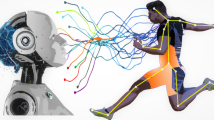Abstract
With the rapid development of artificial intelligence, intelligent auxiliary systems have been widely used in various fields. As a sport, volleyball has high technical requirements, and the traditional volleyball teaching method has certain limitations. Therefore, the purpose of this study is to design an intelligent auxiliary system using artificial muscle integrated optical equipment to realize real-time monitoring and accurate evaluation of volleyball teaching, so as to assist coaches to accurately guide students’ movement skills. The system uses artificial muscle integrated optical equipment, and collects the movement data of students in volleyball training in real time through optical sensors. Machine learning algorithms are used to analyze and identify the data to accurately assess the student’s movements. The system is equipped with an interactive interface that shows students correct demonstrations of movements and provides real-time feedback and guidance. Through experimental verification, the intelligent assistant system can monitor students’ movements in real time, accurately evaluate their technical level, and provide personalized guidance. With the aid of using the system, the volleyball technique level of students has been improved, and the teaching effect has been significantly enhanced.





Similar content being viewed by others
Data availability
The data will be available upon request.
References
Balasas, D.G., Christoulas, K., Stefanidis, P., Vamvakoudis, E., Bampouras, T.: The effect of beach volleyball training on muscle performance of indoor volleyball players. J. Sports Med. Phys. Fit. 58(9), 1240–1246 (2018)
Davenport, T.H., Ronanki, R.: Artificial intelligence for the real world. Harv. Bus. Rev. 96(1), 108–116 (2018)
Fujii, H., Managi, S.: Trends and priority shifts in artificial intelligence technology invention: A global patent analysis. Econ. Anal. Policy 58, 60–69 (2018)
Gil-Arias, A., Diloy-Peña, S., Sevil-Serrano, J., García-González, L., Abós, Á.: A hybrid tgfu/se volleyball teaching unit for enhancing motivation in physical education: A mixed-method approach. Int. J. Environ. Res. Public Health 18(1), 110–117 (2021)
Goralski, M.A., Tan, T.K.: Artificial intelligence and sustainable development. Int. J. Manag. Educ. 18(1), 100330–100336 (2020)
Junior, N.K.M.: Specific periodization for the volleyball: The importance of the residual training effects. MOJ Sports Med 4(1), 4–11 (2020)
Kam, B.S., Yune, S.J., Lee, S.Y., Im, S.J., Baek, S.Y.: Impact of video feedback system on medical students’ perception of their clinical performance assessment. BMC Med. Educ. 19(1), 1–7 (2019)
Kim, I.: Exploring changes to a teacher’s teaching practices and student learning through a volleyball content knowledge workshop. Eur. Phys. Educ. Rev. 22(2), 225–242 (2016)
Kumar, R., Kumar, A., Pal, A.: Overview of hydrogen production from biogas reforming: Technological advancement. Int. J. Hydrog. Energy 47(82), 34831–34855 (2022)
Lu, H., Li, Y., Chen, M., Kim, H., Serikawa, S.: Brain intelligence: Go beyond artificial intelligence. Mob. Netw. Appl. 23, 368–375 (2018)
Mascaró, M., Sacristán, A.I., Rufino, M.M.: For the love of statistics: Appreciating and learning to apply experimental analysis and statistics through computer programming activities. Teach. Math. Appl. Int. J. IMA 35(2), 74–87 (2016)
Papadopoulou, S.D., Giatsis, G., Billis, E., Giannakos, A., Bakirtzoglou, P.: Comparative analysis of the technical-tactical skills of elite male beach volleyball teams. Sport Sci. 13(1), 59–66 (2020)
Pei, Z., Wang, Y.: Analysis of computer aided teaching management system for music appreciation course based on network resources. Compu.-Aided Des. Appl. 19(S1), 1–11 (2021)
Salles, W.D.N., Collet, C., Porath, M., Milistetd, M., Nascimento, J.V.D.: Factors associated to performance efficacy of technical-tactical actions in volleyball. Rev. Bras. Cineantropometria Desempenho Hum. 19, 74–83 (2017)
Shaw, J., Rudzicz, F., Jamieson, T., Goldfarb, A.: Artificial intelligence and the implementation challenge. J. Med. Internet Res. 21(7), e13659–e13665 (2019)
Silva, A.F., Clemente, F.M., Lima, R., Nikolaidis, P.T., Rosemann, T., Knechtle, B.: The effect of plyometric training in volleyball players: A systematic review. Int. J. Environ. Res. Public Health 16(16), 2960–2967 (2019)
Yin, Y.: Research on ideological and political evaluation model of university students based on data mining artificial intelligence technology. J. Intell. Fuzzy Syst. 40(2), 3689–3698 (2021)
Zhang, C., Lu, Y.: Study on artificial intelligence: The state of the art and future prospects. J. Ind. Inf. Integr. 23, 100224–100228 (2021)
Funding
The authors have not disclosed any funding.
Author information
Authors and Affiliations
Contributions
FL has done the first version, XH has done the simulations. All authors have contributed to the paper’s analysis, discussion, writing, and revision.
Corresponding author
Ethics declarations
Competing interests
The authors declare no competing interests.
Ethical approval
Not applicable.
Additional information
Publisher's Note
Springer Nature remains neutral with regard to jurisdictional claims in published maps and institutional affiliations.
Rights and permissions
Springer Nature or its licensor (e.g. a society or other partner) holds exclusive rights to this article under a publishing agreement with the author(s) or other rightsholder(s); author self-archiving of the accepted manuscript version of this article is solely governed by the terms of such publishing agreement and applicable law.
About this article
Cite this article
Liu, F., Hang, X. Design of artificial intelligence volleyball teaching intelligent assistant system based on artificial muscle integrated optical equipment. Opt Quant Electron 56, 455 (2024). https://doi.org/10.1007/s11082-023-06243-0
Received:
Accepted:
Published:
DOI: https://doi.org/10.1007/s11082-023-06243-0




